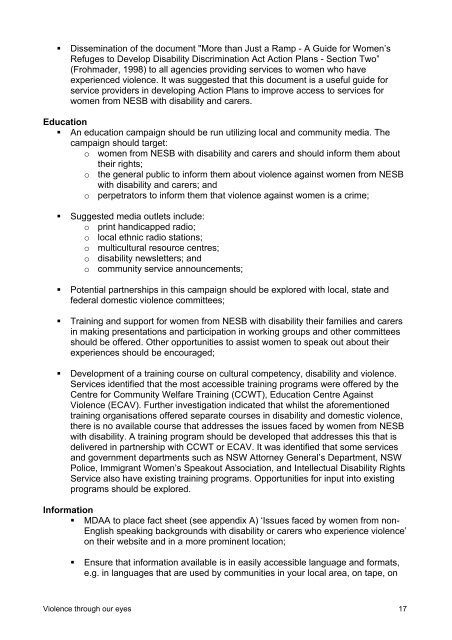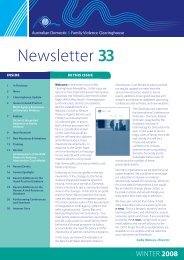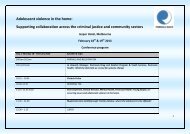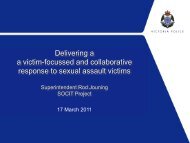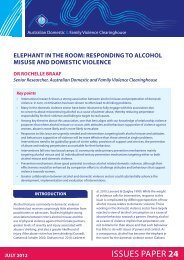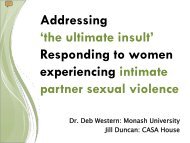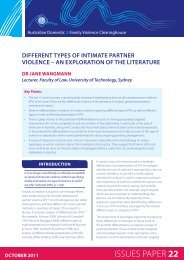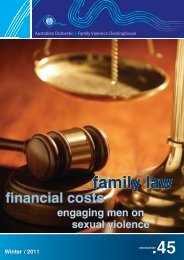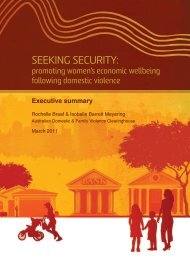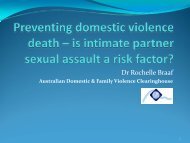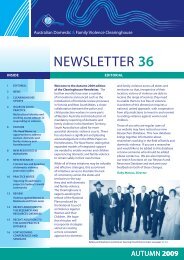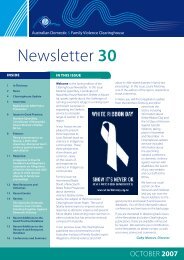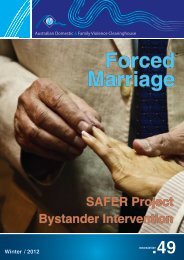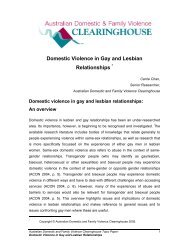Violence through our eyes - Women With Disabilities Australia
Violence through our eyes - Women With Disabilities Australia
Violence through our eyes - Women With Disabilities Australia
Create successful ePaper yourself
Turn your PDF publications into a flip-book with our unique Google optimized e-Paper software.
• Dissemination of the document "More than Just a Ramp - A Guide for <strong>Women</strong>’s<br />
Refuges to Develop Disability Discrimination Act Action Plans - Section Two”<br />
(Frohmader, 1998) to all agencies providing services to women who have<br />
experienced violence. It was suggested that this document is a useful guide for<br />
service providers in developing Action Plans to improve access to services for<br />
women from NESB with disability and carers.<br />
Education<br />
• An education campaign should be run utilizing local and community media. The<br />
campaign should target:<br />
o women from NESB with disability and carers and should inform them about<br />
their rights;<br />
o the general public to inform them about violence against women from NESB<br />
with disability and carers; and<br />
o perpetrators to inform them that violence against women is a crime;<br />
• Suggested media outlets include:<br />
o print handicapped radio;<br />
o local ethnic radio stations;<br />
o multicultural res<strong>our</strong>ce centres;<br />
o disability newsletters; and<br />
o community service announcements;<br />
• Potential partnerships in this campaign should be explored with local, state and<br />
federal domestic violence committees;<br />
• Training and support for women from NESB with disability their families and carers<br />
in making presentations and participation in working groups and other committees<br />
should be offered. Other opportunities to assist women to speak out about their<br />
experiences should be enc<strong>our</strong>aged;<br />
• Development of a training c<strong>our</strong>se on cultural competency, disability and violence.<br />
Services identified that the most accessible training programs were offered by the<br />
Centre for Community Welfare Training (CCWT), Education Centre Against<br />
<strong>Violence</strong> (ECAV). Further investigation indicated that whilst the aforementioned<br />
training organisations offered separate c<strong>our</strong>ses in disability and domestic violence,<br />
there is no available c<strong>our</strong>se that addresses the issues faced by women from NESB<br />
with disability. A training program should be developed that addresses this that is<br />
delivered in partnership with CCWT or ECAV. It was identified that some services<br />
and government departments such as NSW Attorney General’s Department, NSW<br />
Police, Immigrant <strong>Women</strong>’s Speakout Association, and Intellectual Disability Rights<br />
Service also have existing training programs. Opportunities for input into existing<br />
programs should be explored.<br />
Information<br />
• MDAA to place fact sheet (see appendix A) ‘Issues faced by women from non-<br />
English speaking backgrounds with disability or carers who experience violence’<br />
on their website and in a more prominent location;<br />
• Ensure that information available is in easily accessible language and formats,<br />
e.g. in languages that are used by communities in y<strong>our</strong> local area, on tape, on<br />
<strong>Violence</strong> <strong>through</strong> <strong>our</strong> <strong>eyes</strong> 17


